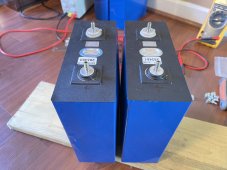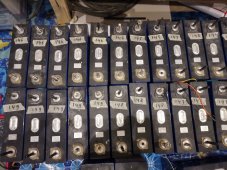The LFP cell will likely not set on fire (we have one example right here in the forums of a puncture that DID set it on fire, BTW). The stuff around it will (as you know). That's why I say put it outside and use it so you don't risk your property.
The electrolyte voltage:
*
https://www.powerstream.com/LLLF.htm
*
https://www.planetanalog.com/how-to-charge-lithium-iron-phosphate-rechargeable-batteries/
*
https://www.mpoweruk.com/lithium_failures.htm
and plenty more ...
Edit: when I say "roll" I mean that these rectangular prismatic cells ARE a long strip of anode/separate/cathode rolled into a rectangular structure.
Thank you for your links.
They inform about general lithium,and not about the electrolyte.
I really do like to know in-depth research.
The general info sites, I could write one by head, with more accurate and detailed information then the 3 links.
Good for a newbie to start leaning.
Not really. As they treat all lithium as the same and then start to talk about difference.
They should not compare at all.
As they are so much different.
With different values, charge cycles, charge graphs, levels etc.
Starting by putting them in one basket is the root of the problem where people think LiFePO4 is dangerous, as lithium polymer is.
(Both have the word lithium, so both must be dangerous, yes?)
Too high voltage can/ will cause some lithium plating what will reduce the capacity.
Lithium plating is also the natural occurrence, the one that will reduce the capacity over time.
In 20 years it is theoretically over.
0% capacity left.
The folding of the layers looks like the mouse stairs (correct English?) you folded as a kid with 2 ribbon.

English is not my native language, perhaps that's called a roll. I don't know.
The fire?
That was me!!

I had fire a few months ago, and it wasn't from puncture.
Any short will cause heat.
Having a MDF sheet on top of that, will heat up the MDF to a level it starts smoldering.
Different materials have different response on heat.
The LiFePO4 didn't caused the fire.
A short wire did.
Capacity test on that cell (who got really hot!) Is 144Ah.
Run the test 3 times to be sure.
Several other cells who didn't got hot also are 144Ah.
All the cells will be used, none recycled.
it's easy to tell when it's not your money.
So no, puncture did not cause fire
Bare wire short (a lead from temperature sensor) did give fire
It also would have done that on lead acid, or any other power source.
Normally it would just glow.
Wood and something glowing...
Not a good combination.








